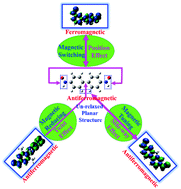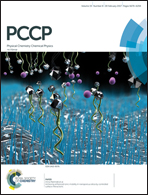Diradicalized biphenyl derivative carbon-based material molecules: exploring the tuning effects on magnetic couplings†
Abstract
While the conductance behavior of carbon-based couplers has been successfully investigated, insight into the magnetic properties of such carbon-based molecule coupled diradical systems is still scarce, and especially the structural effect of such couplers on the magnetic properties is poorly understood. The present work reports three different interference effects on the magnetic properties of carbon-based molecule coupled nitroxide diradicals: twisting, sideways group, and position effects. DFT calculations reveal that (i) torsion does not change their broken-symmetry singlet ground state and antiferromagnetic coupling, but decreases their magnetism; (ii) different linkages of two radical moieties result in different ground states and thus different magnetisms, depending on a combination of meta-sites and para-sites; (iii) the antiferromagnetic coupling with a broken-symmetry singlet ground state is not changed by adding sideways groups, but the coupling magnitude can be tuned by modifying the side-bridge. Discussions on geometries, magnetic properties, SOMO–SOMO splittings, and spin density distributions are made to clarify relevant magnetic behaviors. Clearly, the findings concerning the regulation of the diradicalized material molecules through modifying the carbon-based bridges provide a comprehensive understanding of the magnetism of such carbon-based diradicals and new prospects for the design of building blocks of magnetic functional molecular materials.



 Please wait while we load your content...
Please wait while we load your content...